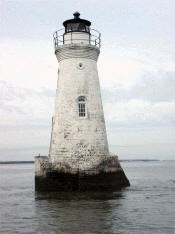
FOPU Situated on an islet off the southeastern tip of Cockspur Island marking the South Channel of the Savannah River, the Cockspur Lighthouse is stands twelve miles east of the port of Savannah. The islet, often covered by high tide, is comprised of oyster shells, and marsh grass. Documented references suggest the first brick tower, used as a daymark, was built on Cockspur Island between March 1837 and November 1839. In 1848, John Norris, a New York architect, was contracted to supervise construction of an illuminated station. The noted architect designed many of Savannah's grand structures including the U.S. Custom House in downtown Savannah, the Mercer-Wilder House, and the Green-Meldrim House, where General Sherman stayed during the Civil War. Norris's duties were to "repair, alter, and put up lanterns and lights on Cockspur Island...and to erect a suitable keeper's house." This first tower had a focal plane 25' above sea level. The beacon housed a fixed white light emanating from five lamps with 14" reflectors visible for nine miles. Tragedy struck again in 1854 when the structure was destroyed by a hurricane. The tower was rebuilt and enlarged on the same foundation the next year. At the start of the American Civil War, the light was temporarily extinguished. On April 10, 1862, Union forces in eleven batteries stretching along the beach at Tybee Island, started a long range bombardment of Fort Pulaski. Thirty-six guns participated in a thirty-hour siege of the fort with the Cockspur Lighthouse in direct line of fire. Following the surrender of Fort Pulaski on April 11, 1862, the little beacon miraculously only suffered minor damage. Theories abound as to why the tower escaped destruction. One theory suggests to effectively hit the Fort walls approximately 1,500 yards distant, Union artillerists had to fire shots at a high angle, thus passing over the tower. This strategy, coupled with the short duration of battle could explain why the tower was spared. Soon after war's end, April 25, 1866, the beacon was relit and painted white for use as a daymark. Throughout it's life, hurricanes plagued the Cockspur Light. August 27, 1881, a massive storm struck Cockspur Island causing water to rise 23' above sea level. The storm surge filled the lighthouse interior and destroyed the Keeper's residence. Jeremiah Keane, the Assistant Keeper Charles Sisson, and two Fort Pulaski caretakers took refuge inside the Northwest stair tower of the brick fort when the great hurricane of 1893 struck. A two story cottage originally built atop the Fort Pulaski for an Ordnance Sergeant would be used by the light keeper in 1906. Man, not nature, extinguished forever the little light. No longer would this light guide vessels up the shallow South Channel of the Savannah River. To accommodate large freighters, the increasingly busy Savannah port routed vessels to the deep, more navigable North Channel. Effective June 1, 1909, the beacon light was snuffed. As the threat to the beacon by salvage crews and other private interests grew, the National Park Service looked into the acquisition of the light. On August 14, 1958, by presidential proclamation, the Cockspur Lighthouse was transferred from the United States Coast Guard to the National Park Service. The National Park Service is dedicated to the preservation of this historic marker. Due to ongoing preservation efforts, the lighthouse and lighthouse island are closed to the public. However, an overlook trail offers visitors the best chance to get a closer look at the lighthouse today. 
FOPU |
Last updated: June 4, 2016
